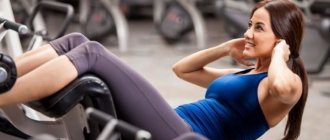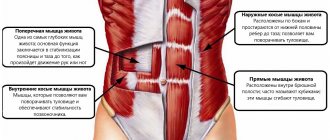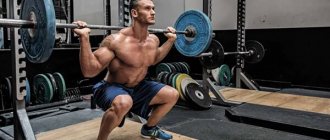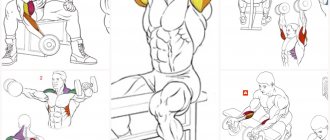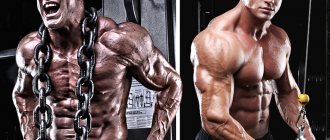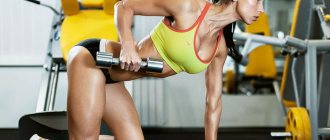Imagine the sixth century BC.
The blood-red sun rises over Sparta.
Armed demigods begin a new day of endless labor, honing their muscles on the athletic machines of antiquity.
Naked fighters engage in brutal sparring, warriors run long distances in full gear, and everyone else competes in endurance.
Everyone is tired and dehydrated, because they deliberately endure hunger in order to learn to endure any physical discomfort.
Now go ahead in our time machine!
Two guys with neat beards are moving towards the local gym, holding a glass of Frappuccino in their hands.
They study while discussing interesting topics such as a new avant-garde band, their favorite fast food sandwich or the best retro filter on Instagram.
After their workout, they drink a cookie-flavored protein shake, post something motivational on Facebook, and Google the meaning of their sleep.
SOMETHING WENT WRONG!
In ancient civilizations, training was of great, vital importance.
“War is a rehearsal for sport, sport is a rehearsal for war” (Flavius Philostratus, 200 AD).
For fitness enthusiasts in 2017, getting in shape means updating your Instagram profile.
Although today's science has advanced far in the study of human physiology, the most effective solutions have not changed for millennia.
Think about it: modern fitness ideals only emerged in the last hundred years, but ancient civilizations spent centuries developing their workouts. Maybe we should listen to them?
NB: let’s be clear right away - we do not encourage you to live exactly like a Spartan.
And while the movie 300 is great, we do not support torture, starvation, or infanticide.
And the management of your gym, by the way, will not approve if you smear yourself with oil.
Progressive load
The main reason why people slow down their results in strength or aesthetics is a lack of structure.
They either do too much, too quickly, or they are lazy.
Both approaches lead you to stagnation and loss of motivation.
The solution is proposed by Milo of Croton, a Greek athlete from Croton, Italy, who lived around 520 BC. BC and mentioned by Herodotus, Pindar, Plutarch and other ancient Greek and Roman authors. Competing in wrestling, he won six times at the Olympic Games, six times at the Pythian Games, nine at the Nemean and ten at the Isthmian.
As a child, Milon dreamed of becoming the strongest athlete in Greece.
To build up his strength, he carried a calf on his shoulders.
He did this every day, and the calf, mind you, grew, so did its strength.
Years later, at the ancient Olympics, he stepped into the stadium, sparkling and beautiful, with a bull on his shoulder.
Although this is a myth, it perfectly illustrates the principles of progressive overload.
Every time you train, you should improve in some way, even adding a 5-pound weight plate to the bar, even just doing a few extra reps, even cutting the rest between sets a few seconds, etc.
If you constantly increase the load, you constantly progress.
This is science.
Hi, friend!
Let me ask you a question. For what purpose do most guys go to the gym?
I'm sure our answers will be very similar!
Often, guys who go to the gym strive for ONE GOAL.. To create a Muscular, Sculpted body that friends and acquaintances will discuss with admiration, and girls will eagerly admire..
They want to build Powerful, Lean and Functional muscles, which were possessed by the Great Ancient Heroes - Achilles, Spartacus, King Leonidas and his 300 Brave Warriors.. They want to achieve a body that they will be proud of!
But, unfortunately, most guys quit the race without getting closer to their goal...
Lack of correct knowledge, lack of time for frequent trips to the gym, inability to pay every month for a subscription, loss of motivation due to lack of results...
Together, these reasons led a large number of guys astray from the path to their cherished goal, who did not even realize that the right path was MUCH closer than they thought!
HOW I FOUND MY WAY TO THE BODY OF THE WARRIOR OF SPARTA
If you are reading these lines, then most likely you are one of the million subscribers to my YouTube channel.
But in case you've never heard of me, or don't know how I got into bodyweight training, here's a quick recap of the last year and a half of my life!
At the beginning of 2020, I decided to travel to Poland to find myself and fulfill my fitness aspirations! By that time, my body was far from the ideal that I was striving for.. The reason for this was irregular training, poor nutrition and other obstacles that were stronger than my desire to change.. And before leaving for Poland, I made a promise to myself that I would train, through thick and thin!
Upon arrival, I discovered that the money I had saved was not enough for the gym, and even barely enough for food! And this situation could last at least another 4 months! But my desire for training could not be extinguished, they were my only way to the top, and then I decided...
I will conquer home workouts with my weight, I will get the most out of them!
AND I STARTED WORKING WITH FULL DEVOTION
My only available equipment was the floor, so I had to become a master at using it, finding the optimal combination of exercises and sequences to overload the muscles and continue to progress!
And, after a month, I started seeing results that I couldn't believe!
My body began to completely transform, the fat was gone, the muscles became dense, plump and defined, the abs began to acquire clear detail! My motivation was high and I continued to study and experiment, finding ways to take my workout to the next level every time!
After another two months, my body was unrecognizable, the fat was completely gone, the muscles became larger and more prominent than ever, and, looking now at the photo, before leaving for Poland and after 3 months of working with my weight, I can confidently to say that I achieved the image of the Warrior of Sparta, the lean, sculpted and functional body that I was striving for!
Seeing my results and the results of my apartment friends who trained under my guidance, I decided to create a YouTube channel in order to share with more people the training methods that helped me create the body I wanted!
And throughout the year, I continued to improve, hone and expand my knowledge in the field of training without any equipment, collecting information bit by bit and through my own experience, I tested what works and what doesn’t..
And, after a year and a half, I am happy to announce that all my knowledge, experience in training and proper nutrition have been combined into one universal solution..
MEET THE “WARRIOR OF SPARTA” PROGRAM
“Warrior of Sparta” is a unique training program in terms of content and implementation, the like of which you will not find in RuNet!
Periodization
Another reason why people stagnate in the gym is the lack of any measurable goal.
Something is better than nothing, right?
Not true.
It is very important to decide what you are working on and organize your routine accordingly.
The ancient Greeks developed their own system. Philostratus, a Greek sage living during the Roman Empire, described it in his work on gymnastics.
The “quaternary system” is a cycle of four days, each of which is dedicated to its own activity. The first day prepares the athlete, the second is full-body training, the third is rest, the fourth is work at an average pace and with an average load. On the first day, the exercises are short, intense, which prepares the athlete's body for the second day. The second intense day will take all the athlete’s strength. The third day will direct his energy in the right direction, and on the last day the athlete will train his stance and hold his opponent.”
This approach was tested in the Roman gladiatorial schools and is consistent with modern principles of periodization.
In simple terms, periodization is structuring your training to optimize it towards a specific goal.
For example, if your breasts are “sagging,” periodize your workouts.
All the most famous trainings include elements of periodization.
Get organized already!
Set of exercises
Having tried a lot of unusual exercises on himself to gain a terrifying amount of muscle mass and destroy any manifestation of fat in the body, Gerard came to a number of conclusions. He made three important changes : his diet, his training, and his mentality (to even think like a warrior). To achieve this goal in such a short time, he invited Mark Twight , a famous American climber and author of legendary books and articles about extreme ascents. In addition, Butler always had a personal fitness trainer next to him . After strength training, Gerard Butler learned to wield a sword and spear, practiced tricks and fight choreography. He trained 6 hours a day for 4 months. Gerard dedicated part of his life to achieving the required physique for this role and ultimately delivered amazing results. Instead of sticking to the usual classic program aimed at pumping up individual muscle groups, Gerard Butler performed unusual exercises . Flipping a huge tire, doing exercises on gymnastic rings and other unconventional exercises pumped his entire body and constantly stimulated his muscles to grow and develop. To look like a warrior, you need to spare yourself and train like a warrior. Let us introduce you to the most famous Spartan workout, in which you need to complete 3 hundred repetitions of various exercises as quickly as possible.
Recovery: sex and wine
They say that trees grow when the weather is calm and sunny, and not when there is a storm - that's when they become strong.
In other words, the gym is a place where you give your muscles stress, and they grow after training.
So if you work hard at the gym and spend your time at home eating Whoppers and staying up until 5am, you're not doing yourself any better.
The recovery phase is VERY important, and the ancients knew this better than anyone.
The ancient Indian document Caraka Saṃhitā, written in Sanskrit, emphasizes this:
Physical exercise causes tension, fatigue, bleeding, thirst, hunger, shortens breathing, causes coughing, fever, and vomiting.
Greek athletes understood the importance of adequate rest and recovery, which are the basis of any training.
Philosophers argued that too intense and harsh training exhausts a person and causes health problems.
Therefore, massage and spa treatments were included in ancient training plans.
Hippocrates, for example, said that if you take a walk after training, your body will become stronger and better rested.
The old devil also offered this recovery option:
Get drunk once or twice, but not to the point of complete loss of memory, after which sexual intercourse should follow.
Bodyweight training
Many of those whose workouts fail simply didn't find enough time or didn't have the right equipment.
The golden age of bodybuilding and the Weider era are often shamed for turning fitness into a money empire, promoting splits, isolation machines and expensive nutritional supplements as the only way to build muscle.
In the ancient world, however, athletes relied on their own weight to build muscle and strength.
And there is a lot of good in this simplicity!
Walk into any gym and you'll see rows and rows of shiny machines, and almost no space for doing dumbbells or doing push-ups.
We're not forcing you to give up machines entirely—avoiding barbells is stupid, to say the least—but to increase your effectiveness or diversify your workouts, add bodyweight exercises!
If you have time to surf Facebook, you can also find 15 minutes of push-ups.
Ancient Greek athletes generally practiced with what they could find.
Stones, animals - everything was used, and for cardio you could beat up a helot.
We can repeat this today, for example:
build some heavy metal structure in your garden, clear the backyard of debris, etc.
Use your imagination!
Basic exercises with kettlebells in CrossFit
The specificity of this sport is that there is no approved list of movements. The CrossFit motto is “Prepare for the unknown.” Kettlebell exercises are selected based on the principle of greatest prevalence and accessibility to people with any level of training. The main ones for mastering the complexes are the following.
Swings or Swings
There are two types of kettlebell swing - “show the judge your ears”, or a swing with both hands behind the head, and the usual “Russian swing”, that is, a swing to waist level. A beginner begins to master the exercises from the second option. He stands in a stance that is convenient for deadlifts and squats, turns his socks around, places the weight between his legs strictly in the center, grabs the handle with a direct grip, and removes the weight from the platform by extending the knee joints. Next, he swings between the legs and sharply straightens the hip and knee joints. By inertia, the weight flies out to waist level. Then the movement is repeated. This exercise is used both for strength endurance and to strengthen the buttocks, back, and back of the thighs.
“Show the judge your ears” or “American swing” requires the ability to use both hands at the same time, good shoulder mobility, and explosive power. The lifting technique is the same; it is important to maintain the adducted shoulder blades and a tense, arched position of the back. The exercise requires activation of not only the posterior chain, but also the shoulders, so it is recommended for everyone with normal joint mobility.
Important information about the kettlebell swing:
- This is not a squat, but a biomechanical deadlift. Imagine that you can pull and jump forward at the same time, this will give an understanding of the work of the hips;
- Swings are not a warm-up exercise. Before them, you need to warm up your body well and prepare both your core and joints for work;
- The exercise is performed exactly as long as the athlete can maintain a tense, arched position of the back. As soon as it relaxes and begins to round in the thoracic region, the exercise should be stopped;
- A simple trick helps you avoid catching “no turnips” in competitions - take a lighter weight, and practice the movement through the full amplitude, and not “as necessary,” until the ballistic nature of the movement is developed at the level of habit, nothing will come of it
Crossfit exercises! Swing the kettlebell! Mikhail Prygunov
Kettlebell push (short amplitude)
In CrossFit, they are most often performed with two hands, and the technique resembles a regular weightlifting push. But one-handed execution is also possible.
The technique of the push looks like this:
- Hips and feet – in a position convenient for a front squat;
- Kettlebells in front of you, symmetrically;
- The grip is straight, there is no need to use a “monkey” grip, it does not allow you to hold the weights firmly;
- Due to extension in the knees and pelvis, the weights are thrown to the shoulders;
- Your arms need to be bent at the elbows, your forearms should be brought to your sides;
- Then, in one motion, push the weights up from your shoulders, straightening your elbows;
- Perform lowering exercises in the reverse order - sit down and lower the weights to your shoulders, then drop them to the floor
Important: it is not recommended to press the weights with your hands from the shoulders; the movement is not considered completed if the athlete’s elbows are not fully extended. Contrary to popular belief, non-straightened elbows are a more traumatic option than pushing directly onto straight arms. A technical error is also the incorrect position of the palm on the bar. If the kettlebell is hanging from the fingers, the athlete will be pushing it into a disadvantageous position with locked wrists.
Kettlebell Front Squats
This is one of the variations of front squats. It is simpler than the barbell squat. The variation with one kettlebell in the hands in front of the chest is called a “goblet” or goblet squat. It is a technical precursor to the classic barbell squat, and teaches how to flex your hips and knees at the same time.
Many people study and perform the goblet with a technical error - they try to move the pelvis back. In fact, in this exercise you need to keep your spine neutral and your back almost straight, so that you bend your legs primarily at the knees and not at the pelvis. This leads to an even distribution of the load between all joints. This version of the squat is the safest.
The correct technique is:
- The projectile is grabbed either by the arms from the sides, or “hugged” by the palms, and they are, as it were, placed in a bowl under the weight;
- The lowering begins by spreading the knees to the sides and lowering the pelvis below the knees. This position allows you to keep the spine neutral;
- Depth – the pelvis is below the knees, but not below the point at which the spine seems to “unwind” and we see a pronounced “dive” of the pelvis.
Goblet Squat / Goblet Squats. Crossfit
Overhead Kettlebell Lunges
This exercise can be done with one or two kettlebells. Usually with one it is more difficult, since the weight of the projectile is not evenly distributed. For beginners, it is better to start learning the movement with the usual version, when light weights are held in straight, outstretched arms.
The projectiles are brought up with a technically correct push, and thrown so that the handles of the weights lie in the middle of the palm.
The technique is like this:
- Bring the weights up, carefully align them, bring your shoulder blades toward your spine and lower them;
- Take a step back with one leg, lower into a lunge, bending the supporting and “front” legs at the knees and hip joint;
- The thigh of the working leg should be parallel to the floor, and the pelvis should fall below the knee. In this case, the back should remain straight, the weights are not held by turning the shoulders;
- The abdomen needs to be pulled in and the pelvis needs to be stabilized. As you exhale, the legs at the knees straighten, the athlete straightens completely;
- Beginners should perform the exercise first with one leg, then with the other, experienced ones can alternate
Lunges with kettlebells overhead. Crossfit
Kettlebell row to the chin from a squat
The English-language name in Russian has taken root more in the community, as has the exercise itself. Many of our CrossFit gyms still don't have a rowing machine, and rowing has to be replaced with this movement. It's quite similar to the sumo deadlift.
You need to do it like this:
- Get into the widest sumo position that is comfortable for your hips. Place the weight in the center in front of you;
- Grab the handle of the kettlebell with both hands, the grip is tight, not on the fingertips;
- Extend your hips and knees while simultaneously pulling the weight toward your chin by bending your elbows;
- Lower the weight to the starting position and repeat
Sumo kettlebell row to the chin. Crossfit
In a healthy body healthy mind
The Romans and ancient Greeks viewed training as a philosophical act rather than a physical one.
For them, this was part of a full-fledged education, “a healthy mind in a healthy body.”
The "Palaestra", the ancient schools, taught the young not only exercises.
However, today fitness has nothing to do with brain function. And this is more like the Cartesian doctrine of the body as an unworthy appendage to the mind.
Recent research has already shown how physical activity and cognitive function are linked: for example, the secretion of endorphins during exercise affects mood and concentration. Exercise affects physical changes in the brain: the connection of nerve cells responsible for learning and memory increases, the speed of neurons increases, blood flow accelerates, and the volume of brain tissue increases.
Various studies have noted that physical activity, especially cardio, improves cognitive function in people of any age.
Food: meat and dried figs
Although the ancient Greek diet of bread, vegetables and fruits is well documented (the "Mediterranean diet"), athletes ate differently.
As today, protein, especially animal protein, was of great importance.
Greek athletes ate fish and pork; the Spartans dined on bulls, oxen, goats and deer.
Particularly indicative is the case of the same Milo of Croton.
After he carried the bull on his shoulders, he ate it whole (of course he was hungry!).
According to the testimony of Athenaeus and Pausanias, Milo's daily diet consisted of 9 kg of meat, 9 kg of bread, and 8.5 liters of wine. In a day.
Your diet is just a preschooler's lunchbox compared to this!
And while the importance of meat is well known today, other cornerstones of the ancient Greek diet have been forgotten.
Figs, for example, were part of the diets of the Romans and ancient Greeks: they were often eaten before competitions.
According to historians, an ancient Greek athlete named Karmis of Sparta claimed that it was a diet of dried figs that led him to victory at the Olympics in 668 BC.
Figs are rich in antioxidants and dietary fiber, high in calories and a natural addition to any muscle-building diet.
Just like today, ancient Greek and Roman athletes relied on certain ergogenic acids to enhance performance.
And it’s unlikely that it was BCAA and creatine monohydrate, but rather boiled donkey hooves, and the father of modern medicine, the Greek physician Galen, recommended ingesting animal testicles.
It sounds scary, but it seems to us that we will get there.
